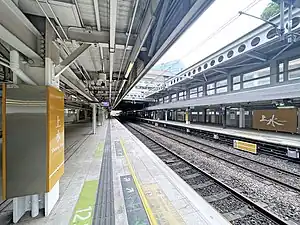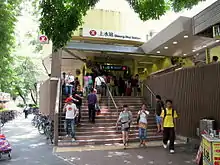Sheung Shui station
Sheung Shui (Chinese: 上水; Cantonese Yale: Seuhngséui; pronounced: [sœːŋ˨.sɵy˧˥], literally "Above-water") is the penultimate northbound station on the East Rail line in Hong Kong. This station serves as the terminus of northbound trains after the Lo Wu and Lok Ma Chau boundary crossings have closed for the day. It is also the last northbound station on the East Rail line that passengers without a Closed Area Permit, Mainland Travel Permit, or valid passport and mainland Chinese visa may freely travel to.
Sheung Shui 上水 | ||||||||||||||||||||||||||||||||||||||||||||||||||||||||||||||||||||||||||||||||||||
|---|---|---|---|---|---|---|---|---|---|---|---|---|---|---|---|---|---|---|---|---|---|---|---|---|---|---|---|---|---|---|---|---|---|---|---|---|---|---|---|---|---|---|---|---|---|---|---|---|---|---|---|---|---|---|---|---|---|---|---|---|---|---|---|---|---|---|---|---|---|---|---|---|---|---|---|---|---|---|---|---|---|---|---|---|
 Platforms 1 and 2 (April 2022) | ||||||||||||||||||||||||||||||||||||||||||||||||||||||||||||||||||||||||||||||||||||
| Chinese name | ||||||||||||||||||||||||||||||||||||||||||||||||||||||||||||||||||||||||||||||||||||
| Chinese | 上水 | |||||||||||||||||||||||||||||||||||||||||||||||||||||||||||||||||||||||||||||||||||
| Jyutping | soeng6 seoi2 | |||||||||||||||||||||||||||||||||||||||||||||||||||||||||||||||||||||||||||||||||||
| Hanyu Pinyin | Shàngshui | |||||||||||||||||||||||||||||||||||||||||||||||||||||||||||||||||||||||||||||||||||
| ||||||||||||||||||||||||||||||||||||||||||||||||||||||||||||||||||||||||||||||||||||
| General information | ||||||||||||||||||||||||||||||||||||||||||||||||||||||||||||||||||||||||||||||||||||
| Location | San Wan Road, Sheung Shui North District, Hong Kong | |||||||||||||||||||||||||||||||||||||||||||||||||||||||||||||||||||||||||||||||||||
| Coordinates | 22°30′04″N 114°07′41″E | |||||||||||||||||||||||||||||||||||||||||||||||||||||||||||||||||||||||||||||||||||
| Owned by | Kowloon-Canton Railway Corporation | |||||||||||||||||||||||||||||||||||||||||||||||||||||||||||||||||||||||||||||||||||
| Operated by | MTR Corporation | |||||||||||||||||||||||||||||||||||||||||||||||||||||||||||||||||||||||||||||||||||
| Line(s) | East Rail line | |||||||||||||||||||||||||||||||||||||||||||||||||||||||||||||||||||||||||||||||||||
| Platforms | 2 (2 side platforms) | |||||||||||||||||||||||||||||||||||||||||||||||||||||||||||||||||||||||||||||||||||
| Tracks | 2 | |||||||||||||||||||||||||||||||||||||||||||||||||||||||||||||||||||||||||||||||||||
| Connections | ||||||||||||||||||||||||||||||||||||||||||||||||||||||||||||||||||||||||||||||||||||
| Construction | ||||||||||||||||||||||||||||||||||||||||||||||||||||||||||||||||||||||||||||||||||||
| Structure type | At-grade | |||||||||||||||||||||||||||||||||||||||||||||||||||||||||||||||||||||||||||||||||||
| Platform levels | 1 | |||||||||||||||||||||||||||||||||||||||||||||||||||||||||||||||||||||||||||||||||||
| Accessible | Yes | |||||||||||||||||||||||||||||||||||||||||||||||||||||||||||||||||||||||||||||||||||
| Other information | ||||||||||||||||||||||||||||||||||||||||||||||||||||||||||||||||||||||||||||||||||||
| Station code | SHS | |||||||||||||||||||||||||||||||||||||||||||||||||||||||||||||||||||||||||||||||||||
| History | ||||||||||||||||||||||||||||||||||||||||||||||||||||||||||||||||||||||||||||||||||||
| Opened | 16 May 1930 | |||||||||||||||||||||||||||||||||||||||||||||||||||||||||||||||||||||||||||||||||||
| Electrified | 15 July 1983 | |||||||||||||||||||||||||||||||||||||||||||||||||||||||||||||||||||||||||||||||||||
| Services | ||||||||||||||||||||||||||||||||||||||||||||||||||||||||||||||||||||||||||||||||||||
| ||||||||||||||||||||||||||||||||||||||||||||||||||||||||||||||||||||||||||||||||||||
| ||||||||||||||||||||||||||||||||||||||||||||||||||||||||||||||||||||||||||||||||||||
| Location | ||||||||||||||||||||||||||||||||||||||||||||||||||||||||||||||||||||||||||||||||||||
 Sheung Shui Location within the MTR system | ||||||||||||||||||||||||||||||||||||||||||||||||||||||||||||||||||||||||||||||||||||
This station is located in the North District, New Territories, Hong Kong, serving the Sheung Shui area and its vicinity.
History
On 1 October 1910, the Kowloon-Canton Railway British Section opened to the public, but Sheung Shui station was not added until 16 May 1930. Full electrification of KCR completed on 15 July 1983.[1] Lok Ma Chau Spur Line was added on 15 August 2007.[2]
In anticipation of an increase in patronage expected to accompany the commissioning of the Lok Ma Chau Spur Line, a new southern concourse was opened at Sheung Shui station in January 2006.[3]
 Former Sheung Shui station concourse, before refurbishment of Lok Ma Chau extension project (August 2006)
Former Sheung Shui station concourse, before refurbishment of Lok Ma Chau extension project (August 2006) The extension of platform 2 with former KCR branded signage (April 2008)
The extension of platform 2 with former KCR branded signage (April 2008) Exterior of the KCR Sheung Shui station (May 2007)
Exterior of the KCR Sheung Shui station (May 2007) Platform 2 of Sheung Shui station (April 2014)
Platform 2 of Sheung Shui station (April 2014)
Layout
Markers were provided on the northbound platform following the opening of Lok Ma Chau station. Two queues, blue and green, are set up at the boarding areas. The blue queues are for passengers travelling to Lo Wu, while the green queues are for those travelling to Lok Ma Chau. Platform 1 is the termination platform of northbound trains after Lo Wu and Lok Ma Chau boundary crossings have closed for the day, and so platform 2 (southbound platform) is the only platform for boarding.
| U1 | concourse | exit, customer service centre, shops, automatic teller machine |
| footbridges | footbridges to Landmark North, transport interchange, bus stops, Sheung Shui Garden, Yuk Po Court, Choi Yuen Commercial Complex | |
| G | ||
| Exit C | exit, customer service centre | |
| Side platform, left doors open | ||
| Platform 1 | East Rail line towards Lo Wu (terminus) → East Rail line towards Lok Ma Chau (terminus) → | |
| Platform 2 | ← East Rail line towards Admiralty (Fanling) | |
| Side platform, left doors open | ||
| Exit D | exit, customer service centre | |
Exits

- Concourse (1/F)[5]
- Exit A
- A1: Choi Yuen Estate (footbridge)
- A2: Choi Yuen Road, Platform 1 to Lo Wu (escalators)
- Exit B
- B1: San Wan Road, Shek Wu Hui (escalators)
- B2: Landmark North (footbridge)
- B3: Sheung Shui Centre (footbridge)
- Exit E
- E: Yuk Po Court, Tai Ping Estate, North District Hospital (footbridge)
- Exit F
- F: Sheung Shui Centre, Sheung Shui Town Centre, North District Town Hall (footbridge)
- Exit A
- Ground (G/F)[5]
- Exit C (connected to platform 1)
- C: Choi Yuen Road
- Exit D (connected to platform 2)
- D1: San Wan Road, Shek Wu Hui, minibus terminus
- D2: San Wan Road, residents' services bus stop
- Exit C (connected to platform 1)
Gallery
 Unpaid area of the station concourse, near Exit A (2022)
Unpaid area of the station concourse, near Exit A (2022) Platform (2021)
Platform (2021) Station Exterior (2021)
Station Exterior (2021) Exit C (2020)
Exit C (2020) Concourse artwork (2020)
Concourse artwork (2020)
References
- Mercedes Hutton (23 July 2020). "How Hong Kong's first electrified rail service, the KCR, arrived – late". South China Morning Post. Retrieved 25 June 2021.
- Anita Lam (15 August 2007). "KCRC unsure of new line's draw". South China Morning Post. Retrieved 25 June 2021.
- "Kowloon-Canton Railway Corporation Annual Report 2006" (PDF). Kowloon-Canton Railway Corporation.
- "Sheung Shui Station layout" (PDF). MTR Corporation. Retrieved 14 November 2014.
- "Sheung Shui Station street map" (PDF). MTR Corporation. Retrieved 14 November 2014.